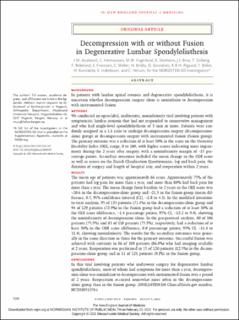| dc.description.abstract | BACKGROUND In patients with lumbar spinal stenosis and degenerative spondylolisthesis, it is uncertain whether decompression surgery alone is noninferior to decompression with instrumented fusion. METHODS We conducted an open-label, multicenter, noninferiority trial involving patients with symptomatic lumbar stenosis that had not responded to conservative management and who had single-level spondylolisthesis of 3 mm or more. Patients were randomly assigned in a 1:1 ratio to undergo decompression surgery (decompressionalone group) or decompression surgery with instrumented fusion (fusion group). The primary outcome was a reduction of at least 30% in the score on the Oswestry Disability Index (ODI; range, 0 to 100, with higher scores indicating more impairment) during the 2 years after surgery, with a noninferiority margin of −15 percentage points. Secondary outcomes included the mean change in the ODI score as well as scores on the Zurich Claudication Questionnaire, leg and back pain, the duration of surgery and length of hospital stay, and reoperation within 2 years. RESULTS The mean age of patients was approximately 66 years. Approximately 75% of the patients had leg pain for more than a year, and more than 80% had back pain for more than a year. The mean change from baseline to 2 years in the ODI score was −20.6 in the decompression-alone group and −21.3 in the fusion group (mean difference, 0.7; 95% confidence interval [CI], −2.8 to 4.3). In the modified intentionto- treat analysis, 95 of 133 patients (71.4%) in the decompression-alone group and 94 of 129 patients (72.9%) in the fusion group had a reduction of at least 30% in the ODI score (difference, −1.4 percentage points; 95% CI, −12.2 to 9.4), showing the noninferiority of decompression alone. In the per-protocol analysis, 80 of 106 patients (75.5%) and 83 of 110 patients (75.5%), respectively, had a reduction of at least 30% in the ODI score (difference, 0.0 percentage points; 95% CI, −11.4 to 11.4), showing noninferiority. The results for the secondary outcomes were generally in the same direction as those for the primary outcome. Successful fusion was achieved with certainty in 86 of 100 patients (86.0%) who had imaging available at 2 years. Reoperation was performed in 15 of 120 patients (12.5%) in the decompression- alone group and in 11 of 121 patients (9.1%) in the fusion group. CONCLUSIONS In this trial involving patients who underwent surgery for degenerative lumbar spondylolisthesis, most of whom had symptoms for more than a year, decompression alone was noninferior to decompression with instrumented fusion over a period of 2 years. Reoperation occurred somewhat more often in the decompressionalone group than in the fusion group. (NORDSTEN-DS ClinicalTrials.gov number, NCT02051374.) | en_US |
